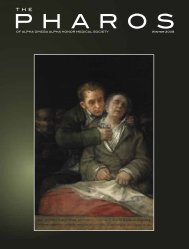The Pharos - Alpha Omega Alpha
The Pharos - Alpha Omega Alpha
The Pharos - Alpha Omega Alpha
Create successful ePaper yourself
Turn your PDF publications into a flip-book with our unique Google optimized e-Paper software.
come to your office, he ought to go to<br />
the hospital emergency room. <strong>The</strong>re<br />
was nothing you could do for him at<br />
home. Moreover, how could you justify<br />
spending an hour or more on a<br />
house call, when you could use the same<br />
amount of time to see several patients<br />
in your office? And what if you missed<br />
a crucial diagnosis because of the lack<br />
of x-ray equipment or specialist consultation?<br />
House calls, along with other<br />
traditional rituals of medical practice,<br />
appeared destined for extinction.<br />
This position seemed unassailable<br />
during the next thirty years, as medicine<br />
transformed itself from a cottage<br />
industry into a vast and powerful technocracy.<br />
Yet the public, which certainly<br />
appreciated the benefits of intensive<br />
care units and organ transplants, began<br />
to experience lingering regret over the<br />
death of personal medicine. By the late<br />
twentieth century, regret had developed<br />
into a sentimental yearning for the return<br />
of the healer’s touch. <strong>The</strong> oldtime<br />
general practitioner evolved into<br />
a therapeutic and moral hero, far more<br />
honored in his absence than he had ever<br />
been when actually present.<br />
In this revisionist view, the Old Doc<br />
was a paragon of compassion, knowhow,<br />
dedication, and seat-of-the-pants<br />
psychology. He—sorry, women docs<br />
were scarce in that patriarchal era—<br />
could, on a single day, perform an appendectomy<br />
on a kitchen table, talk<br />
sense into a young man suffering from<br />
venereal disease, and patiently keep<br />
vigil at the bedside of a dying child.<br />
He exemplified all the professional virtues—integrity,<br />
fidelity, courage, compassion,<br />
and humility—we continue to<br />
celebrate and attempt to create in the<br />
early twenty-first century. But did this<br />
iconic healer ever exist? Surely there<br />
were excellent doctors then just as there<br />
are now. But what were they like? How<br />
much of the ideal Old Doc is based on<br />
reality instead of nostalgia or desire?<br />
A few years ago I came across a book<br />
that presents at least one example of a<br />
plain-speaking but articulate country<br />
doctor who practiced for the first forty<br />
years or so of the twentieth century. <strong>The</strong><br />
Horse and Buggy Doctor is a memoir by<br />
Dr. Arthur E. Hertzler, who graduated<br />
from Northwestern Medical School in<br />
the 1890s and practiced in Halstead,<br />
Kansas. 1 He later opened a clinic and<br />
hospital in Halstead and eventually became<br />
the first professor of surgery at the<br />
University of Kansas Medical School in<br />
Kansas City. 1 For decades Dr. Hertzler<br />
divided his time among his practice in<br />
Halstead, teaching in Kansas City, and<br />
conducting clinical research on wound<br />
healing, chronic appendicitis, neuralgia,<br />
and goiter.<br />
With its publication in 1938, <strong>The</strong><br />
Horse and Buggy Doctor turned its<br />
sixty-eight-year-old author into an overnight<br />
celebrity. <strong>The</strong> book climbed to<br />
number five on that year’s nonfiction<br />
bestseller list, edging ahead of Dale<br />
Carnegie’s How to Win Friends and<br />
Influence People. Its author became so<br />
famous that sixty years later the Kansas<br />
City Eagle proclaimed Arthur Hertzler<br />
one of the most important Kansans of<br />
the twentieth century. While Hertzler<br />
was not a typical country doctor, his<br />
story provides a fascinating background<br />
against which to consider today’s debates<br />
about professionalism, compassion,<br />
and patient-centered medicine.<br />
When Dr. Hertzler hung out his<br />
shingle in the 1890s, patients flocked to<br />
him with scarlet fever, typhoid, empyema,<br />
lockjaw, and pneumonia. He did<br />
what he could for them, which wasn’t<br />
much. Writing forty years later, Hertzler<br />
admitted that most of his treatments<br />
were “merely symbols of good intentions.”<br />
1p78 For fever he employed aspirin<br />
and cold baths. Enemas and castor oil<br />
were among his sure-fire, all-purpose<br />
remedies. He stitched lacerations, set<br />
bones, and delivered babies. He considered<br />
prognosis a major part of the<br />
physician’s work. Though he might not<br />
be able to cure pneumonia, he could at<br />
least tell the patient and family what<br />
to expect. He believed that house calls<br />
conveyed a “sense of security” that was<br />
therapeutic in itself. 1p97<br />
Hertzler almost never refused to<br />
see a patient “no matter what the condition,<br />
or what the chances of remuneration.”<br />
1p107 For him the patient’s<br />
interest always came first, and the doctor’s<br />
primary obligation was to relieve<br />
suffering. “<strong>The</strong> important thing is that<br />
the suffering patient wants action,” he<br />
wrote. 1p56 He believed that the practitioner<br />
needed to understand that “It is the<br />
relief of pain that chiefly interests the<br />
patient, and skill along this line is the<br />
big factor.” 1p52 Indeed, the horse-andbuggy-doctor<br />
carried in his bag plenty<br />
of morphine and laudanum (tincture of<br />
opium) to use liberally to alleviate pain<br />
and anxiety. He criticized doctors who<br />
focused exclusively on the disease while<br />
ignoring the patient’s existential state.<br />
He also stressed the importance of using<br />
the physician-patient relationship in a<br />
conscious way to alleviate the patient’s<br />
fears, anger, and depression, all of which<br />
he believed were barriers to healing.<br />
In many ways Arthur Hertzler exemplifies<br />
the country doctor ideal. He<br />
had compassion. He listened. He never<br />
abandoned his patients. Most of all, he<br />
took their symptoms and suffering very<br />
seriously. Like his contemporary, Dr.<br />
William Carlos Williams, he believed<br />
that empathy lies at the core of healing.<br />
As Williams wrote regarding his<br />
patients, “I lost myself in the very properties<br />
of their minds: for the moment at<br />
least I actually became them, whoever<br />
they should be.” 2<br />
Yet, while Hertzler’s passion for doctoring<br />
demonstrates many of the core<br />
values associated with today’s medical<br />
professionalism, in other respects his<br />
attitudes and behavior differ markedly<br />
from current concepts of professional<br />
ethics. He was a full-fledged paternalist<br />
and anti-intellectualist who felt no<br />
need to sanitize his beliefs for public<br />
consumption. He was a misogynist. He<br />
largely blamed the poor for their own<br />
poverty. In other words, Dr. Hertzler<br />
was a fairly typical man of his times.<br />
<strong>The</strong> concept of patient rights had not<br />
yet been clearly articulated in Hertzler’s<br />
time, but he surely would have opposed<br />
the very idea. He believed that the<br />
<strong>The</strong> <strong>Pharos</strong>/Autumn 2012 19














